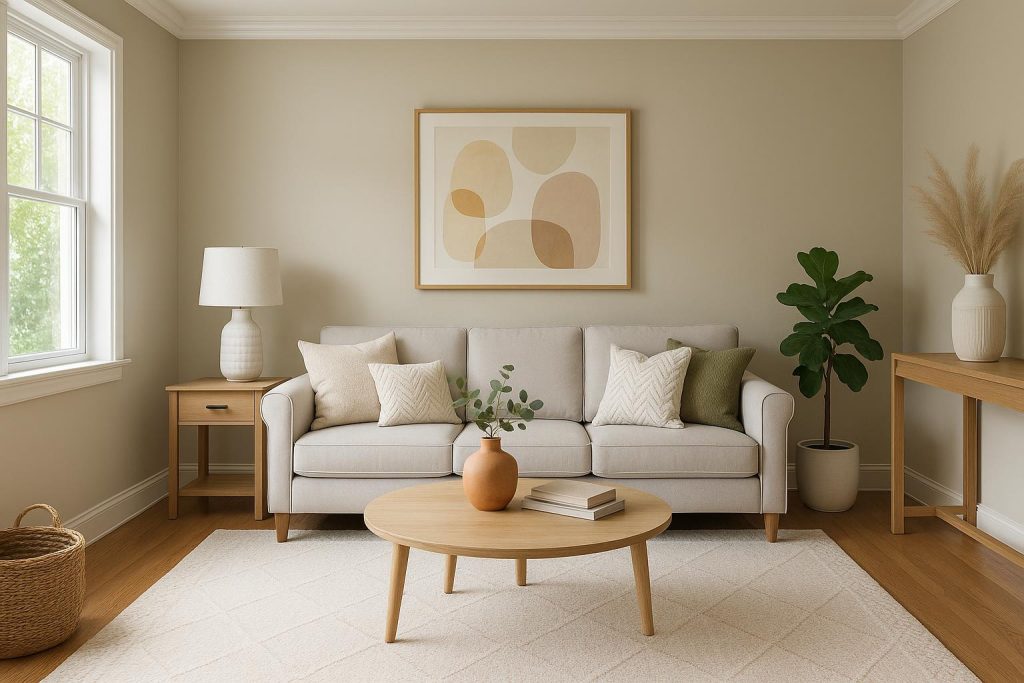When buyers walk into a home, they don’t just see walls and floors—they picture their future. That’s why staging matters. A well-staged home feels welcoming, spacious, and easy to imagine living in.
And the best part? You don’t need a big budget or a professional designer to pull it off. Simple tweaks can make your home stand out and sell faster.
This guide breaks down easy, affordable staging tricks you can start using right away.
Declutter and Depersonalize
One of the fastest ways to make your home more appealing is to clear out the clutter. Buyers want to see open, airy rooms—not crowded spaces filled with personal belongings. Clutter makes a home feel smaller, and it distracts from the features you’re actually trying to highlight.
Start by tackling surfaces. Clear off countertops in the kitchen and bathroom, remove piles of mail, and pare down what’s on coffee tables and shelves. Aim for just a few simple, intentional pieces like a vase, a lamp, or a framed print. This creates breathing room and helps buyers focus on the home itself.
Dan Close, Founder and CEO at We Buy Houses in Kentucky, shared, “Depersonalizing is just as important. Family photos, kids’ artwork, or collections of memorabilia can make buyers feel like they’re walking through someone else’s life. The goal is to create a neutral canvas where they can imagine their own story.”
Pack away personal items, but don’t leave the space feeling sterile. A few generic but tasteful accents—a mirror, a plant, or a neutral piece of art—strike the right balance.
If you’re short on storage, consider renting a small storage unit for the duration of the sale. It keeps your home looking clean and spacious while ensuring your belongings are safely tucked away.
Focus on Curb Appeal
First impressions start before buyers even step inside. If the exterior looks neglected, it can set the wrong tone for the entire showing. Boosting curb appeal doesn’t have to mean expensive renovations—it’s often the small details that make the biggest difference.
Begin with the basics: mow the lawn, trim hedges, and clear away any leaves or debris. If your front door looks worn, a fresh coat of paint in a welcoming color can completely change its impact. Add a new doormat, potted plants, or seasonal flowers to create an inviting entryway.
Don’t forget about lighting. Outdoor lights not only improve safety but also highlight your home’s exterior in the evenings. Solar-powered path lights are an affordable way to make walkways feel warm and welcoming. The goal is to make buyers feel good about the home before they’ve even walked through the door.
Light It Up
Lighting plays a huge role in how people experience a space. Dark, dim rooms can feel small and uninviting, while bright, well-lit spaces feel open and cheerful. Start with natural light—pull back heavy curtains, clean the windows, and let in as much sunlight as possible.
Julian Lloyd Jones, from Casual Fitters says, “For artificial lighting, think in layers. Overhead fixtures provide general light, but they often leave shadows. Add floor or table lamps to create warmth, and consider accent lighting to highlight architectural features like alcoves or fireplaces. If your bulbs are mismatched, replace them with LED bulbs in a soft white tone for a consistent, modern look.”
Mirrors are another simple trick. Placed opposite windows, they reflect natural light and make rooms look bigger. The right lighting setup not only improves the mood of a space but also helps buyers see the home’s best features clearly.
Neutralize Colors and Style
Bold paint colors and overly personal décor might suit your taste, but they can turn off buyers who don’t share the same preferences. When staging, the safest choice is to create a neutral palette that appeals to a wide range of people. Light grays, soft whites, and warm beiges help rooms feel larger and brighter while giving buyers a blank canvas to imagine their own furniture and style.
If repainting the entire home isn’t possible, focus on high-impact areas like the living room, kitchen, and main bedroom. Swap out loud or dated décor for simple, modern touches—a neutral rug, minimal artwork, and clean bedding.
The goal isn’t to strip away all character but to avoid anything that feels too specific or niche. A neutral environment lets buyers picture the home as theirs without distraction.
Rearrange Furniture for Flow
How furniture is arranged can make or break how a room feels. Too much furniture makes spaces seem cramped, while poor placement can block natural pathways. The idea is to create a layout that feels open, functional, and highlights the room’s best features.
LJ Tabango, Founder & CEO of Leak Experts USA explains, “Start by removing oversized or unnecessary pieces. Then, think about traffic flow—buyers should be able to walk through rooms easily without bumping into furniture. Arrange seating to showcase focal points like a fireplace, a large window, or built-in shelving. In small rooms, push furniture slightly away from the wall to create the illusion of more space.”
If you’re unsure, try snapping photos of each room after rearranging. Seeing the space through a camera lens often reveals what feels cluttered or unbalanced. When done right, furniture placement can completely transform how inviting and spacious a room appears.
Conclusion
Staging doesn’t have to mean spending thousands or hiring professionals. By decluttering, brightening rooms, creating flow, and adding simple, inviting touches, you can transform your home into a space buyers connect with right away.
Small changes like neutral colors, better lighting, and boosted curb appeal often have the biggest impact. The goal is to help buyers picture themselves living there—and when they can, your home is more likely to sell quickly and at a better price.
